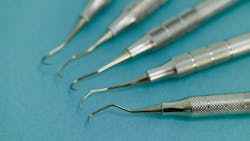Keeping your instruments’ cutting edges: When, why, and how to sharpen
Key takeaways:
-
Sharpen instruments after every 15–40 strokes for best performance
-
Test cutting edges before sharpening to avoid unnecessary wear
-
Use fine-grit sharpening stones with proper angulation
-
Adopt the moving instrument technique for precision edges
-
Sharpen in thirds and maintain instrument design
G. V. Black, one of the founders of modern dentistry, stated in 1908 that "nothing in the technical procedures of dental practice is more important than the care of the cutting edges of instruments."1 Dental professionals are aware of the importance of maintaining sharp instruments, but they are often neglected in the dental office due to time constraints. However, keeping instruments sharp is crucial; doing so can increase the efficiency and effectiveness of calculus removal, improve stroke control, increase patient comfort and satisfaction, and reduce clinician fatigue.2
When to sharpen
The process of calculus removal with periodontal instrumentation inevitably dulls the sharp cutting edge. The loss of metal from the working- end from use transforms the cutting edge from a fine line to a rounded surface, rendering it ineffective. Studies show cutting edges of curettes should be sharpened after approximately 15 to 40 calculus removal strokes.2 Therefore, how often a particular instrument needs to be sharpened varies depending on how frequently it's used and how heavy the calculus deposits are.
Ideally, sterile instruments should be sharpened before use to avoid any risk of disease transfer in the case of an instrument stick or exposure.3 However, instrument sharpening must occur during treatment sometimes. For example, during a scaling and root planing with tenacious calculus deposits, you may need to sharpen frequently used instruments in the middle of treatment to avoid burnishing deposits. With this in mind, it's a good idea to check sharpness on a test stick prior to sharpening to avoid removing unnecessary metal from the working end.
Some periodontal instruments are manufactured with a metal that requires less frequent sharpening.4 A regular sharpening routine will reduce the amount of time needed to maintain the sharp edge, likely only requiring a few light strokes and minor recontouring to restore it. This will make calculus removal easier for both the clinician and the patient. However, neglecting your instruments for long periods of time will make more work for you later, requiring firm sharpening strokes and extensive recontouring to restore the sharp cutting edge.2
Regardless of which instrument sharpening technique you use, knowing the design characteristics of sickle scalers and curettes is imperative to avoid altering the design of the instrument, resulting in an ineffective cutting edge. Sickle scalers, universal curettes, and area-specific curettes such as Gracey curettes all have an internal angle of 70-80 degrees formed between the face and lateral surface, although the face is tilted for area-specific curettes.
Additionally, the design of the lateral surfaces, back, tip, or toe must also be maintained. Sickle scalers are triangular in cross section and have a pointed tip, whereas curettes have a rounded toe that must be maintained. Most sharpening techniques require dividing the cutting edge into three sections, sharpening the heel, middle, and tip or toe thirds to help maintain the instrument's design characteristics.2
What you need to sharpen
The sharpening armamentarium should consist of a sharpening stone, plastic sharpening test stick, gauze, lubricant, gloves, and some type of magnification, such as loupes. There is a variety of sharpening stones on the market with different grits ranging from fine, medium, or coarse. Fine grain stones with a grit of 400 or higher, such as a ceramic synthetic stone, are typically recommended because they produce significantly sharper cutting edges that will maintain sharpness longer.
However, coarse stones, such as a composition synthetic stone, can be used for sharpening metal instruments that are extremely dull or need reshaping. Lubricating the stone helps to prevent metal shavings from sticking to the surface of the stone, which can become embedded, reducing the effectiveness of the stone. Lubrication also reduces the frictional heat between the instrument and the stone. Natural stones, such as the Arkansas stone, require mineral oil for lubrication. Synthetic stones that can be lubricated with water are recommended when sharpening during patient treatment. Sharpening stones and test sticks should be cleaned and sterilized after use.2
How to sharpen
The two most common sharpening techniques are the moving instrument and the moving stone technique. The moving stone technique is often taught in schools to assist beginning clinicians in visualizing angulation. However, a 2014 study concluded that the moving instrument technique produced the most precise cutting edge without creating wire edges and irregularities.5
A sharpening tool known as the Sharpening Horse can be used to hold the sharpening stone in a fixed position, allowing the clinician to view the face-to-stone angulation easier than lying the stone flat on a countertop.6 For both techniques, the angulation between the instrument face and sharpening stone should be between 70 and 80 degrees to maintain the original design characteristics of the working- end. You also need to sharpen in sections for both, rotating the stone or instrument to evenly sharpen the heel, middle, and toe- thirds of the instrument.
If the instrument you are sharpening is a curette, make sure to recontour the rounded toe and back while sharpening. If you are sharpening an area-specific curette, only the lower or working cutting edge needs to be sharpened. Finishing sharpening on a down stroke can help prevent metal burs from forming on the edges of the instrument, which can be wiped away with gauze. A cylindrical sharpening stone can also be used to smooth any wire edges on the cutting edges.
Lastly, a sharpening test stick should be used to evaluate instrument sharpness. Establish your finger rest on the flat, top surface of the stick the way you would on the occlusal surface of a molar. Adapt the cutting edge at a 70-80 degree angle, similar to scaling. If the cutting edge is sharp, it will scratch or catch on the surface of the test stick. A dull edge will slide over the test stick surface. Be sure to test the heel, middle, and toe thirds of the cutting edge to ensure that all sections are sharp.2
Staying sharp
Maintaining sharp instruments is a critical component of patient care that's often overlooked. Many dental offices send their instruments to sharpening companies for occasional sharpening, but it is highly unlikely that this is being done as often as recommended due to cost concerns. Regular sharpening is the best way to keep your instruments' cutting edges sharp, provide efficient and comfortable care for your patients, and reduce strain and fatigue for clinicians.
References
-
Foss CL, Orban TR. Sharpening periodontal instruments. J Periodontol. 1956;27 (2): 135-143. https://doi.org/10.1902/jop.1956.27.2.135
-
Gehrig JS, Sroda R, Saccuzzo D. Fundamentals of periodontal instrumentation & advanced root instrumentation. Enhanced 8th ed. Jones & Bartlett Learning; 2019:594-637.
-
Marquam B. Keep eye on sharpening techniques to prevent disease transmission. RDH. 1992;12(8):20-21, 23.
-
Everedge Technology. HuFriedy Group. 2025. https://www.hufriedygroup.com/en/content/everedge
-
Di Fiore A, Mazzoleni S, Fantin F, Favero L, et al. Evaluation of three different manual techniques of sharpening curettes through a scanning electron microscope: a randomized controlled experimental study. Int J Dent Hyg. 2015;13(2):145-150.
-
The sharpening horse kit. DH Methods of Education. https://www.dhmethed.com/product/the-sharpening-horse-kit/
About the Author

Amy Lemons, MEd, BSDH, RDH
Amy Lemons, MEd, BSDH, RDH, has 13 years of experience and is currently a clinical assistant professor at the OU College of Dentistry in the division of periodontics. She teaches preventive dentistry and periodontal instrumentation to first-year dental students. Most of her work focuses on sharing clinical tips and the latest information in periodontics. Reach her at [email protected].
